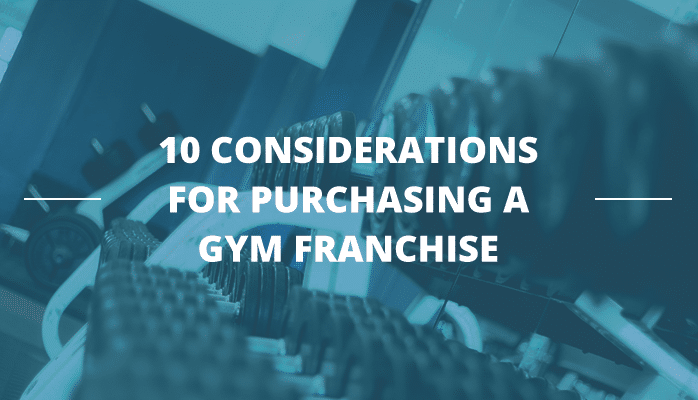


If you’re thinking of owning your own business in 2017, consider purchasing a fitness club franchise. Gym membership spending was up 44% last year, and technological developments are motivating people to lead healthier lives.
To help inform your decision, We have handily listed 10 points to consider when choosing to start out with your own fitness franchise:
 1. Choose the right brand for you and your area
1. Choose the right brand for you and your area
Depending on where you live, there may be several different franchise opportunities available. Carefully research them all and come up with a list of positives and negatives for each.
Compare every element, from start-up and estimated running costs to public perceptions about the brand, commission rates and the time it will take to get the business up and running.
2. Count business costs carefully
Work out the total cost before you commit to anything. It sounds obvious, but as with any business, there are often hidden costs you need to consider.
These include location costs, cost of permits or regulations, business tax, parking costs, equipment costs, employee costs, business insurance and more. After all, a more effective plan will result in fewer surprises during the latter stages of franchise development.
3. Evaluate your personal finances in detail
Fitness club franchises can take a while to start generating income, so you need complete visibility over your personal budget.
Make a spreadsheet of all your monthly outgoings. Include your mortgage or rent, average weekly food shop, childcare, travel and petrol, family outings, bills, insurance and subscriptions. Add in one-off costs that you normally pay in a year, such as car tax, MOT, pet vaccinations, birthday and Christmas gifts, holidays and your TV licence.
Subtract any income you know you will be receiving, for example a partner’s monthly wage, and you’re left with the minimum amount you will need to make every month.
Make sure you keep that figure in mind when you’re creating your business plan.

4. Explore finance options
If you don’t have savings or investment to meet your upfront costs, you should consider finance options. You may qualify for a loan from your bank to cover the franchise costs, for example.
It is also important to remember the cost of initial purchase of equipment and set-up. From the workout area to the cafe, you’ll need to offer the right customer experience to attract customers to return. You can source most of what you need through gym equipment lease or hire purchase to reduce your up-front costs and give you more flexibility with cash flow.
5. Choose the right location
Before you make a commitment, investigate the area to find the ideal site for your franchise.
Is there a lot of local competition already?, is there enough demand for you to open a new gym? And if there are no other gyms around, is there a valid reason for this?
It is always best practice to conduct thorough research in the local area and to ensure that you are aware of any potential issues that may arise.
 6. Research the local competition
6. Research the local competition
Go beyond identifying your future competitors. Find out what your competitors business strengths and weaknesses are from a member perspective. Speak to members to determine why they sign up with particular companies, and what they look for in their ideal gym experience.
This will help you refine the service you offer and market your gym more effectively because you can then provide valid benefits that will make a potential customer choose your service over a competitor.
7. Get to know your customers
Build a customer profile to successfully target your ideal audience.
For example, are you looking for customers who want a more premium gym experience or will you focus towards attracting a student audience, who are looking for a wide range of gym equipment at a low monthly subscription cost.
8. Learn online marketing basics
A cost-effective way to market your gym this is through online and social media channels.
Business profiles on Facebook and Google advertising for instance, will grant you much needed visibility on these platforms. You can also consider investing in Google training to learn marketing basics to support the appearance of your franchise.
9. Expect delays
Setting up a fitness club franchise can be a time-consuming affair. As well as dealing with the franchise company, you’ll need to consult with the council to obtain necessary permits and suppliers to get your facility up and running.
You should factor contingency into your schedule to mitigate against inevitable delays.
 10. Be prepared for hard work
10. Be prepared for hard work
As with any business, owning a gym is hard work. If you haven’t run a business before, you’ll need to spend time learning about marketing, bookkeeping, expense tracking, customer relations, health and safety and more. You’ll have to work long hours to get the business started.
But it’s also a rewarding experience in a growing industry. If you’re prepared to invest the time and effort into making your franchise a success, then you’ll reap the benefits for years to come.
So what are you waiting for?
Key takeaways
- Before purchasing a fitness franchise, carefully work out the start-up and ongoing costs – and make sure you can afford them as well as your personal living costs
- Research the local area to ensure your franchise will fit in and have a have a solid potential customer base
- Consider the full range of finance options to make your venture affordable and enable you to manage cash flow effectively
- Social media and online marketing are key to running a successful gym, so invest
time in learning how to leverage online channels
Our infographic ‘Emerging Fitness Facility & Equipment Trends to Watch in 2017’ focuses on trends that will help you get a bigger slice of the £4.4 billion UK fitness industry. Download it now by clicking on the below button.
This post originally appeared on LinkedIn.


